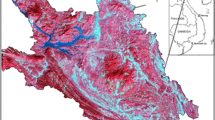Abstract
Extraction of impervious surfaces is one of the necessary processes in urban change detection. This paper derived a unified conceptual model (UCM) from the vegetation-impervious surface-soil (VIS) model to make the extraction more effective and accurate. UCM uses the decision tree algorithm with indices of spectrum and texture, etc. In this model, we found both dependent and independent indices for multi-source satellite imagery according to their similarity and dissimilarity. The purpose of the indices is to remove the other land-use and land-cover types (e.g., vegetation and soil) from the imagery, and delineate the impervious surfaces as the result. UCM has the same steps conducted by decision tree algorithm. The Landsat-5 TM image (30 m) and the Satellite Probatoire d’Observation de la Terre (SPOT-4) image (20 m) from Chaoyang District (Beijing) in 2007 were used in this paper. The results show that the overall accuracy in Landsat-5 TM image is 88%, while 86.75% in SPOT-4 image. It is an appropriate method to meet the demand of urban change detection.
Similar content being viewed by others
References
Yang C J, Zhuo C H. Extracting residential areas on the TM imagery. J Remote Sens, 2000, 4: 146–150
Masek J G, Linday F E, Goward S N. Dynamics of urban growth in the Washington D C metropolitan area, 1973–1996, from Landsat observations. Int J Remote Sens, 2000, 21: 3473–3486
Zhang Q, Wang J, Peng X, et al. Urban built-up land change detection with road density and spectral information from multi-temporal landsat TM data. Int J Remote Sens, 2002, 23: 3057–3078
Jiang Q X, Liu H P. Extracting TM image information using texture analysis. J Remote Sens 2004, 8: 458–464
Xu H Q. Remote sensing information extraction of urban built-up land based on a data-dimension compression technique. J Image Graph, 2005, 10: 223–229
Xu H Q. Fast information extraction of urban built-up land based on the analysis of spectral signature and normalized difference index. GeogrRes, 2005, 24: 311–320
Xu H Q. Modification of normalised difference water index (NDWI) to enhance open water features in remotely sensed imagery. Int J Remote Sens, 2006, 27: 3025–3033
Xu H Q. A new index-based built-up index (IBI) and its eco-environmental significance. Remote Sens Tech Appl, 2007, 22: 301–308
Xu H Q. A new index for delineating built-up land features in satellite imagery. Int J Remote Sens, 2008, 29: 4269 4–276
Ridd M K. Exploring a V-I-S (vegetation-impervious surface-soil) model for urban ecosystem analysis through remote sensing: Comparative anatomy for cities. Int J Remote Sens, 1995, 16: 2165–2185
Madhavan B B, Kubo S, Kurisaki N, et al. Appraising the anatomy and spatial growth of the Bangkok Metropolitan area using a vegetation-impervious-soil model through remote sensing. Int J Remote Sens, 2001, 22: 789–806
Phinn S, Stanford M, Scarth P, et al. Monitoring the composition of urban environments based on the vegetation-impervious surface-soil (VIS) model by subpixel analysis techniques. Int J Remote Sens, 2002, 23: 4131–4153
Xu H Q. A new remote sensing index for fastly extracting impervious surface information. Geom Inf Sci WHU, 2008, 33: 1150–1154
Simard M, Saatchi S S, Grandi G De, et al. The use of decision tree and multiscale texture for the use of decision tree and multiscale texture for forest. IEEE Trans Geosci Remote Sens, 2000, 38: 2310–2321
Zhao P, Feng X Z, Lin G F. The decision tree algorithm of automatically extracting residential information from SPOT images. J Remote Sens, 2003, 7: 309–315
Zhuo C H. Geo-understanding and Geo-analysis of Remote Sensing Image. Beijing: Science Press, 2001. 81–85
Mcfeeters S K. The use of the normalized difference water index (NDWI) in the delineation of open water features. Int J Remote Sens, 1996, 17: 1425–1432
Chen J, He C Y, Shi P J, et al. Land use/cover change detection with change vector analysis (CVA): Change magnitude threshold determination. J Remote Sens, 2001, 5: 259–266
Pan C, Du P J, Luo Y, et al. Decision tree classification of remote sensing images based on vegetation indices. J Comput Appl, 2009, 29: 777–797
Huete A R. A soil-adjusted vegetation index (SAVI). Remote Sens Environ, 1988, 25: 295–309
Luo Y, Xu J H, Yue W Z, et al. A comparative study of extracting urban vegetation information by vegetation indices from thematic mapper images. Remote Sens Tech Appl, 2006, 21: 212–219
Zha Y, Gao J, Ni S. Use of normalized difference built-up index in automatically mapping urban areas from TM imagery. Int J Remote Sens, 2003, 24: 583–594
Wu H G, Jiang J J, Zhang H L, et al. Application of ratio resident-area index to retrieve urban residential areas based on landsat TM data. J NNU (Nat Sci), 2006, 29: 118–121
Author information
Authors and Affiliations
Corresponding author
Rights and permissions
About this article
Cite this article
Qiao, Y., Liu, H., Bai, M. et al. Extracting impervious surfaces from multi-source satellite imagery based on unified conceptual model by decision tree algorithm. Sci. China Technol. Sci. 53 (Suppl 1), 68–74 (2010). https://doi.org/10.1007/s11431-010-3207-1
Received:
Accepted:
Published:
Issue Date:
DOI: https://doi.org/10.1007/s11431-010-3207-1




